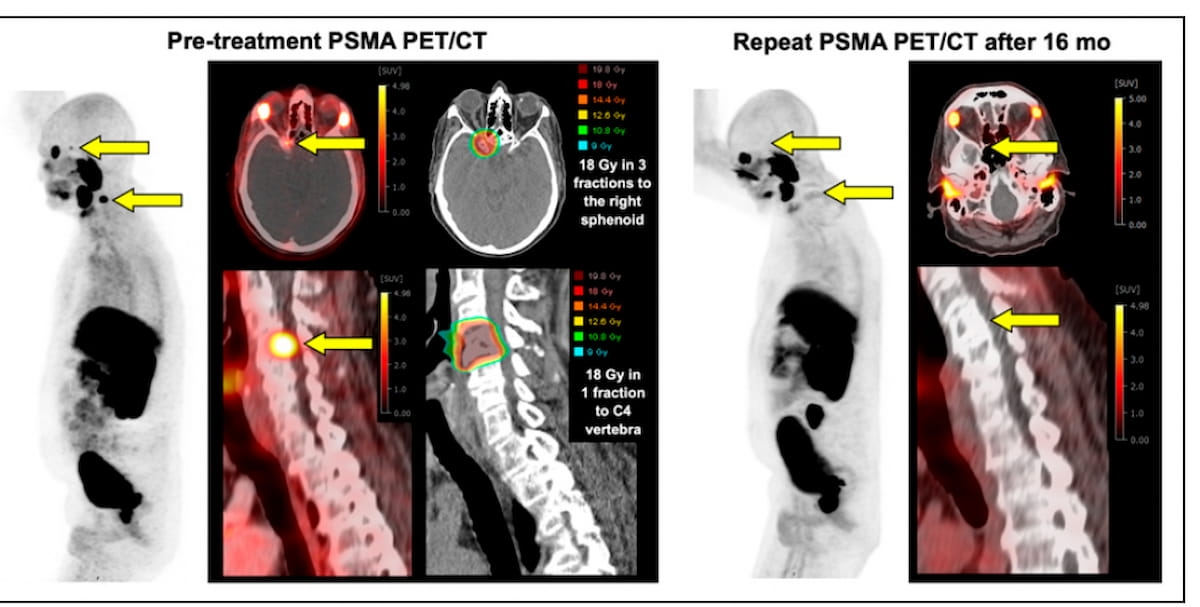For patients with oligometastatic castration-resistant prostate cancer (CRPC), new research suggests that metastasis-directed radiotherapy guided by prostate-specific membrane antigen (PSMA) positron emission tomography/computed tomography (PET/CT) may provide a viable treatment alternative.
In the retrospective study, recently published in the Journal of Nuclear Medicine, researchers reviewed data from 24 patients (median age of 68.8) with metastatic castration-resistant prostate cancer (mCRPC) and PSMA PET/CT findings of up to five sites of oligorecurrent or oligoprogressive disease. All cohort patients received a combination of metastasis-directed radiotherapy and androgen deprivation therapy, according to the study.
The study authors found that PSMA PET/CT-guided metastasis-directed radiotherapy resulted in the following findings:
• a 16.4-month median progression-free survival;
• a 29-month median freedom from a new line of systemic therapy; and
• two- and four-year overall survival rates of 91.1 percent and 68.8 percent respectively.
The findings from the study also revealed no cases involving grade 3 or higher toxicity specific to metastasis-directed radiotherapy and only one patient experienced grade 2 toxicity with worsening urinary incontinence after receiving brachytherapy to the corpus cavernosum.
“In this retrospective cohort of patients with oligometastatic castration-resistant prostate cancer, PSMA PET/CT guided, metastasis-directed radiotherapy achieved durable disease control without significant toxicity,” wrote lead study author John Nikitas, M.D., who is associated with the Department of Radiation Oncology at the University of California, Los Angeles (UCLA), and colleagues.
For patients with nodal metastasis, the study authors noted a greater than threefold longer median progression-free survival in comparison to those with bone or visceral metastasis (39.6 months vs. 12.5 months) as well as a nearly 15 percent higher overall survival rate at two years (100 percent vs. 85.1 percent).
Three Key Takeaways
1. Efficacy of treatment. The treatment showed promising results with a median progression-free survival of 16.4 months and a median of 29 months without needing a new line of systemic therapy.
2. Survival rates. The two-year and four-year overall survival rates were high, at 91.1 percent and 68.8 percent, respectively.
3. Safety profile. The treatment demonstrated a favorable safety profile, with no grade 3 or higher toxicities specific to the therapy and only one patient experiencing grade 2 toxicity.
The researchers also emphasized that previous research combining metastasis-directed radiotherapy with conventional imaging for patients with mCRPC had a greater number of cases of clinical progression with PCa, a shorter median time to new systemic therapy and lower overall survival rates at two years.
“Overall, these cohorts reported worse oncologic outcomes than were foind in our study, suggesting that PSMA PET/CT guidance is associated with improved oncologic outcomes compared with conventional imaging guidance, though more prospective data are needed,” noted Nikitas and colleagues.
(Editor’s note: For related content, see “Next-Generation PSMA Agent 225Ac-FL-020 Gets FDA Fast Track Designation for mCRPC,” “Could Pluvicto Have a Role in Taxane-Naïve mCRPC?: an Interview with Oliver Sartor, MD?” and “PET/CT Shows Superior Results for Detecting Oligometastatic Breast Cancer in Comparison to CT.”)
In regard to study limitations, the researchers noted the retrospective design and the small sample size. They also acknowledged significant variation in the cohort with respect to the number of metastatic sites and use of prior treatments. There was also variation in the systemic therapy and metastasis-directed radiotherapy the cohort patients received, according to the study authors.
